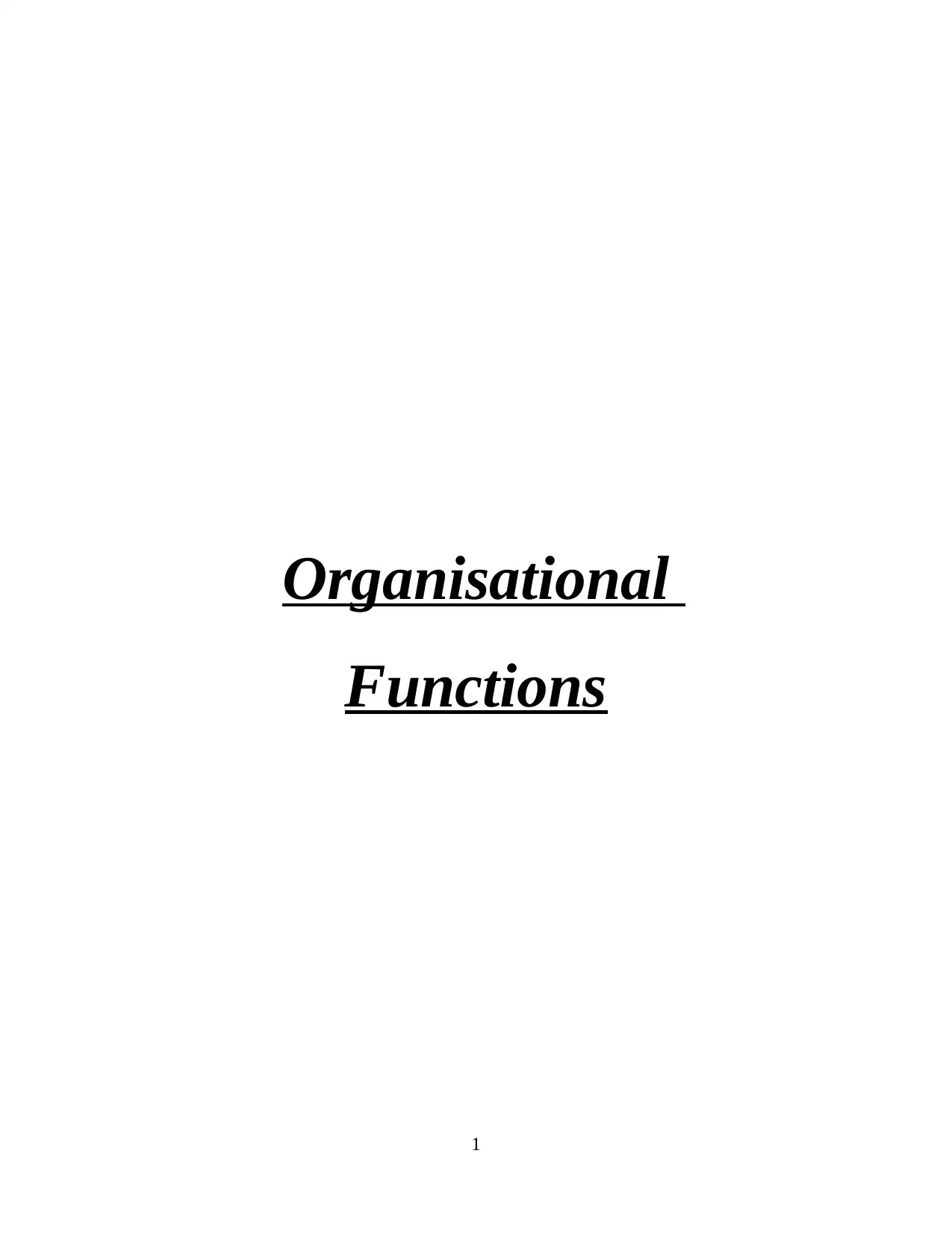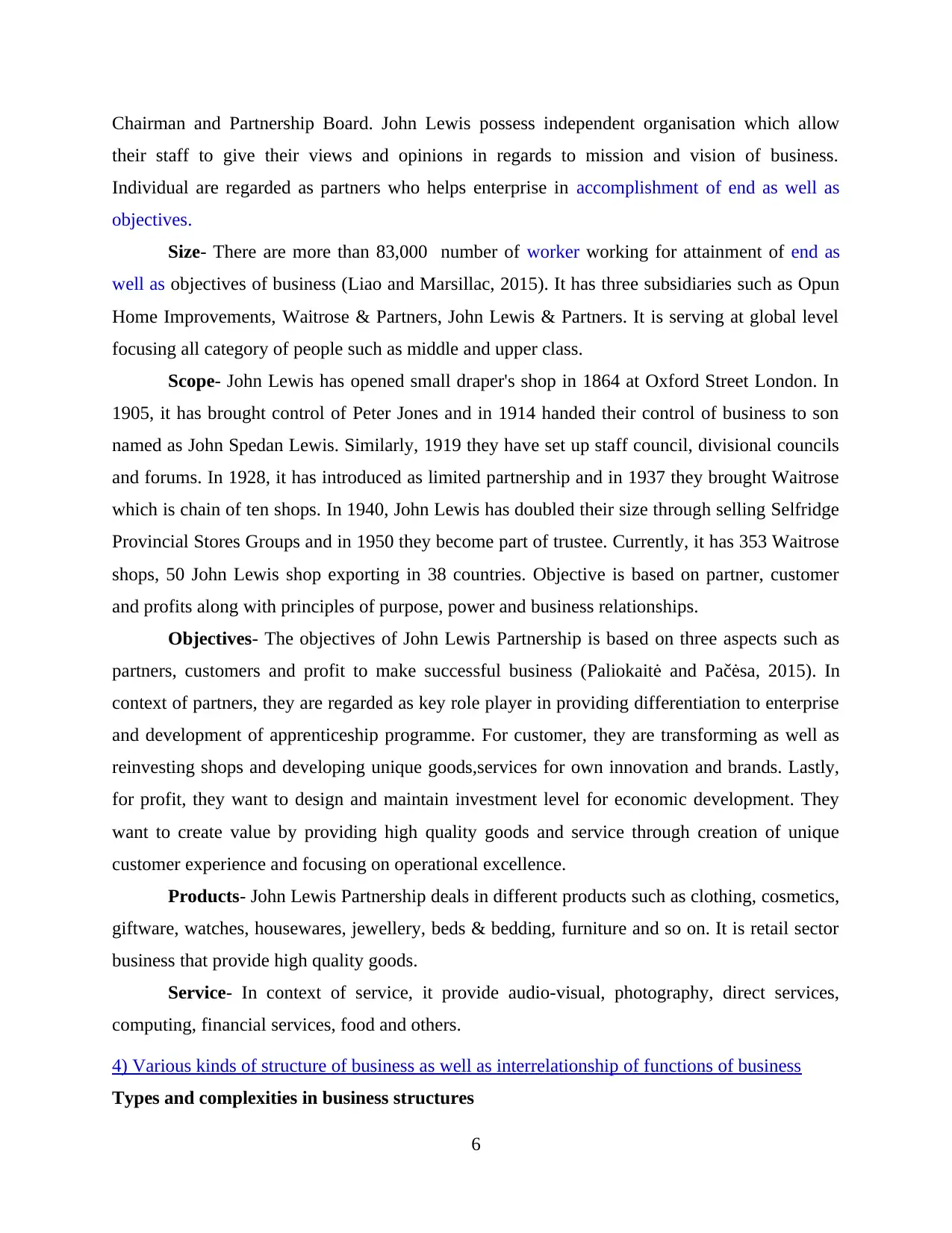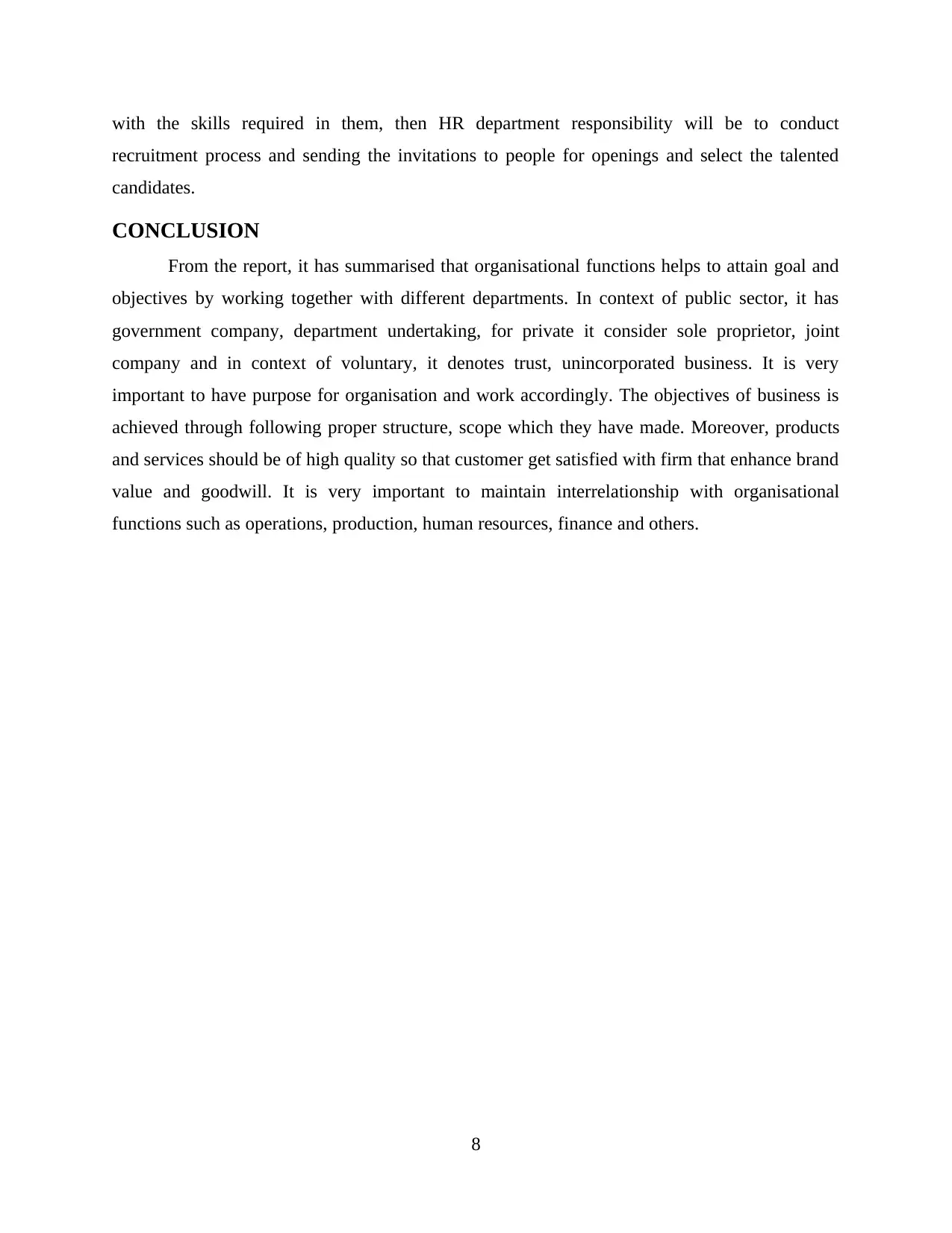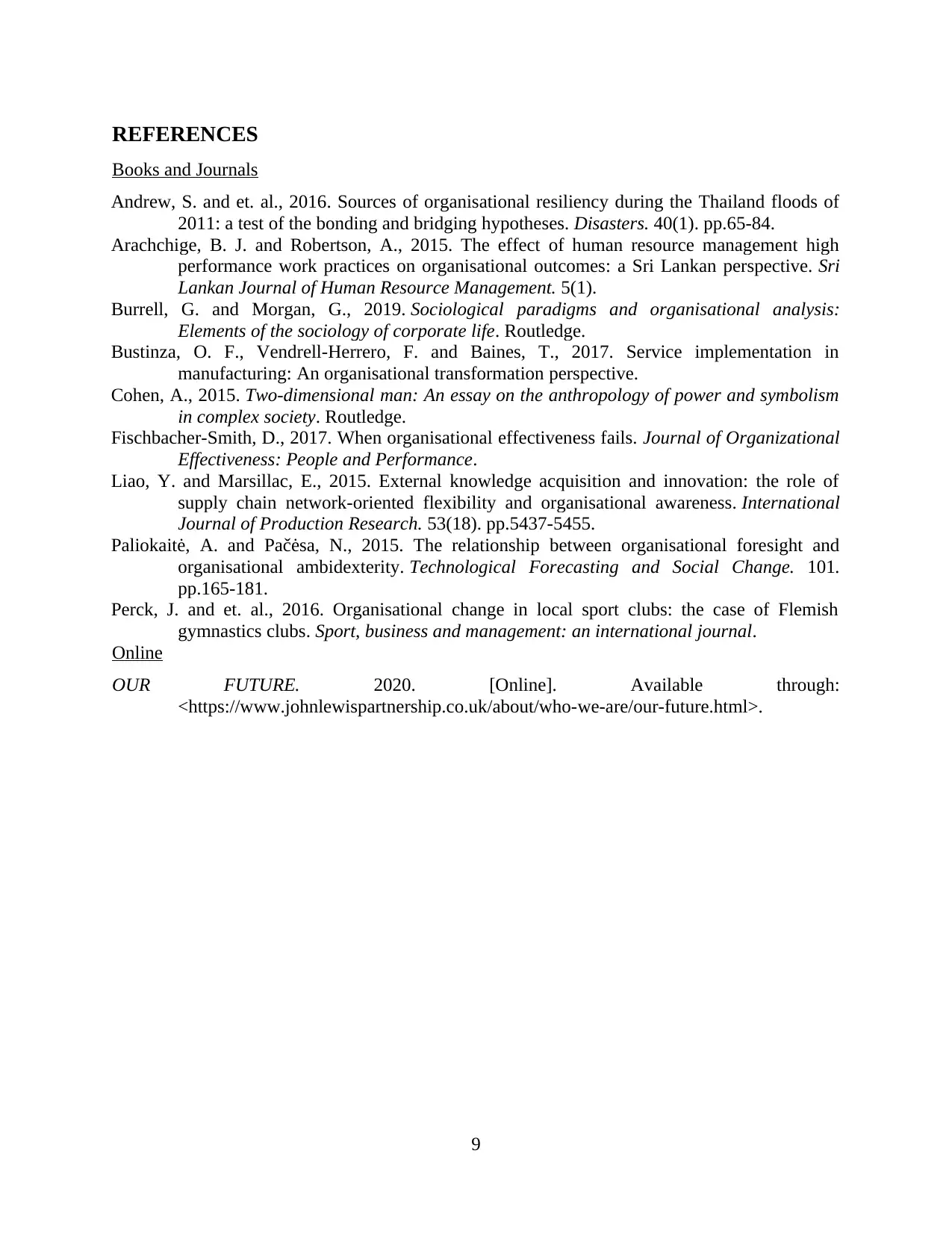Organisational Functions Report: Sectors, Structures, and Functions
VerifiedAdded on 2023/01/12
|10
|2699
|27
Report
AI Summary
This report provides a detailed analysis of organisational functions, focusing on public, private, and voluntary sectors. It examines the different types and purposes of each sector, using examples like NHS, John Lewis, and Oxfam. The report delves into the legal structures within the private sector, including sole proprietorships, partnerships, and joint stock companies. Furthermore, it discusses various organisational structures, their size, scope, objectives, and the creation of products and services. A case study on the John Lewis Partnership is included, exploring its structure, size, scope, objectives, products, and services. The report also highlights the interrelationship between different organisational functions, such as production, sales, and human resources, and concludes with a summary of the key findings. The importance of communication and coordination between departments is emphasized throughout the analysis.

Organisational
Functions
1
Functions
1
Paraphrase This Document
Need a fresh take? Get an instant paraphrase of this document with our AI Paraphraser

Table of Contents
INTRODUCTION...........................................................................................................................3
MAIN BODY...................................................................................................................................3
1) Various kinds as well as purposes of enterprise named as public, private and voluntary
sectors.....................................................................................................................................3
2) Various types of legal structures in context of private sectors...........................................5
3) Discuss about different types of organisational structure their size, scope along with
objectives of business to achieve them and creation of products and services sold at market
place........................................................................................................................................5
4) Various kinds of structure of business as well as interrelationship of functions of business. 6
CONCLUSION................................................................................................................................8
REFERENCES................................................................................................................................9
2
INTRODUCTION...........................................................................................................................3
MAIN BODY...................................................................................................................................3
1) Various kinds as well as purposes of enterprise named as public, private and voluntary
sectors.....................................................................................................................................3
2) Various types of legal structures in context of private sectors...........................................5
3) Discuss about different types of organisational structure their size, scope along with
objectives of business to achieve them and creation of products and services sold at market
place........................................................................................................................................5
4) Various kinds of structure of business as well as interrelationship of functions of business. 6
CONCLUSION................................................................................................................................8
REFERENCES................................................................................................................................9
2

INTRODUCTION
Organisational function is referred as procedure or collection of activities that are carried
out within department of enterprise (Andrew and et. al., 2016). The different types of
organisation functions are marketing, customer service, human resources, information
technology, operations, warehousing, finance, production and many more. The given assignment
is based on John Lewis Partnership that was established in 1929 at London, United Kingdom.
This is regarded as retail sector dealing in supermarket, retail, financial services and many more.
The aim of report is to discuss about purpose and types of private, public, voluntary sectors.
This also covers legal structure of private organisation along with their mission, vision,
objectives and so on. It discuss about interrelationship with different organisational functions and
types of business structures.
MAIN BODY
1) Various kinds as well as purposes of enterprise named as public, private and voluntary sectors
In this part of report, three different enterprises such as public, private and voluntary are
chosen name as NHS, John Lewis and Oxfam. The types and purposes of these sectors are
described below:
Public Organisation
It is defined as concern that is owned as well as run by government in which products and
services are provided to people or community for their benefits (Arachchige and Robertson,
2015). Such business are operated with funds raised through taxes.
Types- The various kinds of public sectors are mentioned below:
Departmental Undertakings- This is regarded as aged types of enterprise that is section of
government section. It does not possess separate existence than government that has operations
as well as functions under single department. For instance, railway, telegraph, post, telephone
services, broadcasting and others.
Public Corporation/ Statutory Corporation- It is defined as business which is formed
through special enactment of central or state legislature or parliaments. Such types of businesses
are financed through authorities of country and their powers, objects and bound are definite by
legislature. For instance, State Bank, Airlines and others.
3
Organisational function is referred as procedure or collection of activities that are carried
out within department of enterprise (Andrew and et. al., 2016). The different types of
organisation functions are marketing, customer service, human resources, information
technology, operations, warehousing, finance, production and many more. The given assignment
is based on John Lewis Partnership that was established in 1929 at London, United Kingdom.
This is regarded as retail sector dealing in supermarket, retail, financial services and many more.
The aim of report is to discuss about purpose and types of private, public, voluntary sectors.
This also covers legal structure of private organisation along with their mission, vision,
objectives and so on. It discuss about interrelationship with different organisational functions and
types of business structures.
MAIN BODY
1) Various kinds as well as purposes of enterprise named as public, private and voluntary sectors
In this part of report, three different enterprises such as public, private and voluntary are
chosen name as NHS, John Lewis and Oxfam. The types and purposes of these sectors are
described below:
Public Organisation
It is defined as concern that is owned as well as run by government in which products and
services are provided to people or community for their benefits (Arachchige and Robertson,
2015). Such business are operated with funds raised through taxes.
Types- The various kinds of public sectors are mentioned below:
Departmental Undertakings- This is regarded as aged types of enterprise that is section of
government section. It does not possess separate existence than government that has operations
as well as functions under single department. For instance, railway, telegraph, post, telephone
services, broadcasting and others.
Public Corporation/ Statutory Corporation- It is defined as business which is formed
through special enactment of central or state legislature or parliaments. Such types of businesses
are financed through authorities of country and their powers, objects and bound are definite by
legislature. For instance, State Bank, Airlines and others.
3
⊘ This is a preview!⊘
Do you want full access?
Subscribe today to unlock all pages.

Trusted by 1+ million students worldwide

Government Company- It is defined as organisation where 51% of cashed up capital is
held through state or central or partly by them. Each and every activities and operations are
performed by government permission.
Purpose- The main purpose of NHS is to promote leadership, developing character of
student studying at secondary level, creation of scholarship for students and rendering services
for people in effective and efficient manner.
Private Organisation
This is referred as that organisation which includes person, corporation, agency and
partnership which is not a public authority and established with aim of earning profits (Burrell
and Morgan, 2019). This considers those enterprise that are established with profit oriented
which are not owned or operated by authorities.
Types- The kind of private system which includes sole proprietorship, partnership,
limited liability company and corporations.
Purpose- The main purpose of respective business is to provide happiness to each and
every members through satisfying employment in order to measure ability to sustain as well as
enhance position of retail business.
Voluntary Organisation
It is defined as union, group, society, association which enter in an statement as
volunteers for forming organisation in order to accomplish goal and objectives.
Types- Some of the kind of voluntary organisation are mentioned here:
Unincorporated Association- This is defined as arrangement that is set up by assistance
of understanding between group of people who comes together to provide services to
community, society rather than making profits. Such kind of enterprise does not need any set up
cost at marketplace. While forming agreements, each and every details are mentioned that should
be followed by members.
Trust- It is defined as firm that is organised in order to perform fiduciary of agencies as
well as trust (Bustinza, Vendrell-Herrero and Baines, 2017). This types of system is owned
through one of the three kind of structures like law business, banks and independent partnership.
In this, there is no compulsion to exercise all types of power provided to them. This consists of
two persons such as trustee and beneficiary to manage as well as operate each and every
activities and functions.
4
held through state or central or partly by them. Each and every activities and operations are
performed by government permission.
Purpose- The main purpose of NHS is to promote leadership, developing character of
student studying at secondary level, creation of scholarship for students and rendering services
for people in effective and efficient manner.
Private Organisation
This is referred as that organisation which includes person, corporation, agency and
partnership which is not a public authority and established with aim of earning profits (Burrell
and Morgan, 2019). This considers those enterprise that are established with profit oriented
which are not owned or operated by authorities.
Types- The kind of private system which includes sole proprietorship, partnership,
limited liability company and corporations.
Purpose- The main purpose of respective business is to provide happiness to each and
every members through satisfying employment in order to measure ability to sustain as well as
enhance position of retail business.
Voluntary Organisation
It is defined as union, group, society, association which enter in an statement as
volunteers for forming organisation in order to accomplish goal and objectives.
Types- Some of the kind of voluntary organisation are mentioned here:
Unincorporated Association- This is defined as arrangement that is set up by assistance
of understanding between group of people who comes together to provide services to
community, society rather than making profits. Such kind of enterprise does not need any set up
cost at marketplace. While forming agreements, each and every details are mentioned that should
be followed by members.
Trust- It is defined as firm that is organised in order to perform fiduciary of agencies as
well as trust (Bustinza, Vendrell-Herrero and Baines, 2017). This types of system is owned
through one of the three kind of structures like law business, banks and independent partnership.
In this, there is no compulsion to exercise all types of power provided to them. This consists of
two persons such as trustee and beneficiary to manage as well as operate each and every
activities and functions.
4
Paraphrase This Document
Need a fresh take? Get an instant paraphrase of this document with our AI Paraphraser

Purpose- Main purpose of Oxfam is to assist in order to make long term result for
unfairness of poorness. This is regarded as section of world motion alteration as well as creation
of better forthcoming that is escaped from poorness as well as secure.
2) Various types of legal structures in context of private sectors
Legal structure of concern is chosen when arrangement form or establish new
organisation at marketplace. The various legal construction in private sector are as follows:
Sole Proprietorship- This is referred as those company that is operated and run by
individual and there is sharing of risks as well as profits by themselves (Cohen, 2015). This is
referred as oldest as well as simplest types of business. Sole proprietorship is easy to start and
dissolve with following of minimum restriction. For instance, grocery shop, tailor, barber,
carpenter and so on.
Partnership- It is defined as those business in which two or more people are working
collectively in order to earn profits as well as sharing of risk equally. This is formed by signing
agreement of partnership which includes authorised capital, number of share and many more. In
this, all partners possess equal rights as well as responsibility for business.
Joint Stock Companies- This is formed when organisation has limited financial
resources as well as huge risk burden. For raising of capital, organisation has to sale shares of
different values to people (Fischbacher-Smith, 2017). The managing body of joint stock
companies includes board of directors, CEO and others. This may be public limited as well as
private limited company. Here private is composed of two or more but there is limit up to 50
members and government has no right to intervene. On other hand, public limited membership is
open for all which contain minimum number of members to be 7 and there is no limit for
maximum.
3) Discuss about different types of organisational structure their size, scope along with objectives
of business to achieve them and creation of products and services sold at market place
It is very important to understand structure, size, scope, objectives, products and service
of John Lewis and accordingly plan, policies and strategy should be formulated as well as
implemented. They are as follows:
Structure- The structure of John Lewis Partnership is to design in order to safeguard
future of organisation through enhancement of prosperity as well as ensuring integrity. In top
level, respective organisation has three governing bodies named as Partnership Council,
5
unfairness of poorness. This is regarded as section of world motion alteration as well as creation
of better forthcoming that is escaped from poorness as well as secure.
2) Various types of legal structures in context of private sectors
Legal structure of concern is chosen when arrangement form or establish new
organisation at marketplace. The various legal construction in private sector are as follows:
Sole Proprietorship- This is referred as those company that is operated and run by
individual and there is sharing of risks as well as profits by themselves (Cohen, 2015). This is
referred as oldest as well as simplest types of business. Sole proprietorship is easy to start and
dissolve with following of minimum restriction. For instance, grocery shop, tailor, barber,
carpenter and so on.
Partnership- It is defined as those business in which two or more people are working
collectively in order to earn profits as well as sharing of risk equally. This is formed by signing
agreement of partnership which includes authorised capital, number of share and many more. In
this, all partners possess equal rights as well as responsibility for business.
Joint Stock Companies- This is formed when organisation has limited financial
resources as well as huge risk burden. For raising of capital, organisation has to sale shares of
different values to people (Fischbacher-Smith, 2017). The managing body of joint stock
companies includes board of directors, CEO and others. This may be public limited as well as
private limited company. Here private is composed of two or more but there is limit up to 50
members and government has no right to intervene. On other hand, public limited membership is
open for all which contain minimum number of members to be 7 and there is no limit for
maximum.
3) Discuss about different types of organisational structure their size, scope along with objectives
of business to achieve them and creation of products and services sold at market place
It is very important to understand structure, size, scope, objectives, products and service
of John Lewis and accordingly plan, policies and strategy should be formulated as well as
implemented. They are as follows:
Structure- The structure of John Lewis Partnership is to design in order to safeguard
future of organisation through enhancement of prosperity as well as ensuring integrity. In top
level, respective organisation has three governing bodies named as Partnership Council,
5

Chairman and Partnership Board. John Lewis possess independent organisation which allow
their staff to give their views and opinions in regards to mission and vision of business.
Individual are regarded as partners who helps enterprise in accomplishment of end as well as
objectives.
Size- There are more than 83,000 number of worker working for attainment of end as
well as objectives of business (Liao and Marsillac, 2015). It has three subsidiaries such as Opun
Home Improvements, Waitrose & Partners, John Lewis & Partners. It is serving at global level
focusing all category of people such as middle and upper class.
Scope- John Lewis has opened small draper's shop in 1864 at Oxford Street London. In
1905, it has brought control of Peter Jones and in 1914 handed their control of business to son
named as John Spedan Lewis. Similarly, 1919 they have set up staff council, divisional councils
and forums. In 1928, it has introduced as limited partnership and in 1937 they brought Waitrose
which is chain of ten shops. In 1940, John Lewis has doubled their size through selling Selfridge
Provincial Stores Groups and in 1950 they become part of trustee. Currently, it has 353 Waitrose
shops, 50 John Lewis shop exporting in 38 countries. Objective is based on partner, customer
and profits along with principles of purpose, power and business relationships.
Objectives- The objectives of John Lewis Partnership is based on three aspects such as
partners, customers and profit to make successful business (Paliokaitė and Pačėsa, 2015). In
context of partners, they are regarded as key role player in providing differentiation to enterprise
and development of apprenticeship programme. For customer, they are transforming as well as
reinvesting shops and developing unique goods,services for own innovation and brands. Lastly,
for profit, they want to design and maintain investment level for economic development. They
want to create value by providing high quality goods and service through creation of unique
customer experience and focusing on operational excellence.
Products- John Lewis Partnership deals in different products such as clothing, cosmetics,
giftware, watches, housewares, jewellery, beds & bedding, furniture and so on. It is retail sector
business that provide high quality goods.
Service- In context of service, it provide audio-visual, photography, direct services,
computing, financial services, food and others.
4) Various kinds of structure of business as well as interrelationship of functions of business
Types and complexities in business structures
6
their staff to give their views and opinions in regards to mission and vision of business.
Individual are regarded as partners who helps enterprise in accomplishment of end as well as
objectives.
Size- There are more than 83,000 number of worker working for attainment of end as
well as objectives of business (Liao and Marsillac, 2015). It has three subsidiaries such as Opun
Home Improvements, Waitrose & Partners, John Lewis & Partners. It is serving at global level
focusing all category of people such as middle and upper class.
Scope- John Lewis has opened small draper's shop in 1864 at Oxford Street London. In
1905, it has brought control of Peter Jones and in 1914 handed their control of business to son
named as John Spedan Lewis. Similarly, 1919 they have set up staff council, divisional councils
and forums. In 1928, it has introduced as limited partnership and in 1937 they brought Waitrose
which is chain of ten shops. In 1940, John Lewis has doubled their size through selling Selfridge
Provincial Stores Groups and in 1950 they become part of trustee. Currently, it has 353 Waitrose
shops, 50 John Lewis shop exporting in 38 countries. Objective is based on partner, customer
and profits along with principles of purpose, power and business relationships.
Objectives- The objectives of John Lewis Partnership is based on three aspects such as
partners, customers and profit to make successful business (Paliokaitė and Pačėsa, 2015). In
context of partners, they are regarded as key role player in providing differentiation to enterprise
and development of apprenticeship programme. For customer, they are transforming as well as
reinvesting shops and developing unique goods,services for own innovation and brands. Lastly,
for profit, they want to design and maintain investment level for economic development. They
want to create value by providing high quality goods and service through creation of unique
customer experience and focusing on operational excellence.
Products- John Lewis Partnership deals in different products such as clothing, cosmetics,
giftware, watches, housewares, jewellery, beds & bedding, furniture and so on. It is retail sector
business that provide high quality goods.
Service- In context of service, it provide audio-visual, photography, direct services,
computing, financial services, food and others.
4) Various kinds of structure of business as well as interrelationship of functions of business
Types and complexities in business structures
6
⊘ This is a preview!⊘
Do you want full access?
Subscribe today to unlock all pages.

Trusted by 1+ million students worldwide

Hierarchical Organizational Structure- This structure typically feature multiple layers
of management. Here the hierarchy is formed on vertically. In this structure vertical chain of
command is followed as a basic level of organizing and managing employees with their
responsibilities (Perck and et. al., 2016). Hierarchical Organisation structure prevents cross team
communication. This structure is a tall organisational structure because the people here follows
many hierarchy to give and receive orders.
Matrix Organisational Structure- In this organisational structure a person who belongs
to one department (say production) can easily communicate with other departments (say sales or
marketing). This structure enhance communication and prohibits any grievance among
departments. This kind of structure may have people belonging to different groups. The merit of
this structure is that now the employees aim is not to consider their department goal but to take
account the whole organisational goal.
As with the case of John Lewis, the company practices flat organisational structure. The
company tries to minimize the departments as much as possible and as short as possible. The
company follows the partnership structure where it considers his employees as partners of
company. It also gives a share from his profit to employees. Not only this, the organisation takes
decision after consulting it from all the workers.
Relevance of the interrelationship of different organisational functions
Production and sales department- Communication between production and sales
department is very essential (Andrew and et. al., 2016). As in case of John Lewis, the company's
production department can produce the products according to the sales force or the sales
department will trained their force according to the volumes of production and sets the targets
accordingly. This will result in minimum inventory of finished goods. Production accordingly
can help an company in cost savings, large amount of inventory, failure in meeting the required
targets and the like. Therefore, communication between these two departments is necessary.
All department and Human resource departments- Human resource are taken as an
important resource in all organisation because it is they only who takes the organisation to next
high level. All the departments need employees for carrying out their work. Therefore, they need
to inform the required number of employees they need for their department to Human resource
department. Then HR department will set his recruitment process accordingly. As with John
Lewis, all the departments inform about the number of work force they will be needing along
7
of management. Here the hierarchy is formed on vertically. In this structure vertical chain of
command is followed as a basic level of organizing and managing employees with their
responsibilities (Perck and et. al., 2016). Hierarchical Organisation structure prevents cross team
communication. This structure is a tall organisational structure because the people here follows
many hierarchy to give and receive orders.
Matrix Organisational Structure- In this organisational structure a person who belongs
to one department (say production) can easily communicate with other departments (say sales or
marketing). This structure enhance communication and prohibits any grievance among
departments. This kind of structure may have people belonging to different groups. The merit of
this structure is that now the employees aim is not to consider their department goal but to take
account the whole organisational goal.
As with the case of John Lewis, the company practices flat organisational structure. The
company tries to minimize the departments as much as possible and as short as possible. The
company follows the partnership structure where it considers his employees as partners of
company. It also gives a share from his profit to employees. Not only this, the organisation takes
decision after consulting it from all the workers.
Relevance of the interrelationship of different organisational functions
Production and sales department- Communication between production and sales
department is very essential (Andrew and et. al., 2016). As in case of John Lewis, the company's
production department can produce the products according to the sales force or the sales
department will trained their force according to the volumes of production and sets the targets
accordingly. This will result in minimum inventory of finished goods. Production accordingly
can help an company in cost savings, large amount of inventory, failure in meeting the required
targets and the like. Therefore, communication between these two departments is necessary.
All department and Human resource departments- Human resource are taken as an
important resource in all organisation because it is they only who takes the organisation to next
high level. All the departments need employees for carrying out their work. Therefore, they need
to inform the required number of employees they need for their department to Human resource
department. Then HR department will set his recruitment process accordingly. As with John
Lewis, all the departments inform about the number of work force they will be needing along
7
Paraphrase This Document
Need a fresh take? Get an instant paraphrase of this document with our AI Paraphraser

with the skills required in them, then HR department responsibility will be to conduct
recruitment process and sending the invitations to people for openings and select the talented
candidates.
CONCLUSION
From the report, it has summarised that organisational functions helps to attain goal and
objectives by working together with different departments. In context of public sector, it has
government company, department undertaking, for private it consider sole proprietor, joint
company and in context of voluntary, it denotes trust, unincorporated business. It is very
important to have purpose for organisation and work accordingly. The objectives of business is
achieved through following proper structure, scope which they have made. Moreover, products
and services should be of high quality so that customer get satisfied with firm that enhance brand
value and goodwill. It is very important to maintain interrelationship with organisational
functions such as operations, production, human resources, finance and others.
8
recruitment process and sending the invitations to people for openings and select the talented
candidates.
CONCLUSION
From the report, it has summarised that organisational functions helps to attain goal and
objectives by working together with different departments. In context of public sector, it has
government company, department undertaking, for private it consider sole proprietor, joint
company and in context of voluntary, it denotes trust, unincorporated business. It is very
important to have purpose for organisation and work accordingly. The objectives of business is
achieved through following proper structure, scope which they have made. Moreover, products
and services should be of high quality so that customer get satisfied with firm that enhance brand
value and goodwill. It is very important to maintain interrelationship with organisational
functions such as operations, production, human resources, finance and others.
8

REFERENCES
Books and Journals
Andrew, S. and et. al., 2016. Sources of organisational resiliency during the Thailand floods of
2011: a test of the bonding and bridging hypotheses. Disasters. 40(1). pp.65-84.
Arachchige, B. J. and Robertson, A., 2015. The effect of human resource management high
performance work practices on organisational outcomes: a Sri Lankan perspective. Sri
Lankan Journal of Human Resource Management. 5(1).
Burrell, G. and Morgan, G., 2019. Sociological paradigms and organisational analysis:
Elements of the sociology of corporate life. Routledge.
Bustinza, O. F., Vendrell-Herrero, F. and Baines, T., 2017. Service implementation in
manufacturing: An organisational transformation perspective.
Cohen, A., 2015. Two-dimensional man: An essay on the anthropology of power and symbolism
in complex society. Routledge.
Fischbacher-Smith, D., 2017. When organisational effectiveness fails. Journal of Organizational
Effectiveness: People and Performance.
Liao, Y. and Marsillac, E., 2015. External knowledge acquisition and innovation: the role of
supply chain network-oriented flexibility and organisational awareness. International
Journal of Production Research. 53(18). pp.5437-5455.
Paliokaitė, A. and Pačėsa, N., 2015. The relationship between organisational foresight and
organisational ambidexterity. Technological Forecasting and Social Change. 101.
pp.165-181.
Perck, J. and et. al., 2016. Organisational change in local sport clubs: the case of Flemish
gymnastics clubs. Sport, business and management: an international journal.
Online
OUR FUTURE. 2020. [Online]. Available through:
<https://www.johnlewispartnership.co.uk/about/who-we-are/our-future.html>.
9
Books and Journals
Andrew, S. and et. al., 2016. Sources of organisational resiliency during the Thailand floods of
2011: a test of the bonding and bridging hypotheses. Disasters. 40(1). pp.65-84.
Arachchige, B. J. and Robertson, A., 2015. The effect of human resource management high
performance work practices on organisational outcomes: a Sri Lankan perspective. Sri
Lankan Journal of Human Resource Management. 5(1).
Burrell, G. and Morgan, G., 2019. Sociological paradigms and organisational analysis:
Elements of the sociology of corporate life. Routledge.
Bustinza, O. F., Vendrell-Herrero, F. and Baines, T., 2017. Service implementation in
manufacturing: An organisational transformation perspective.
Cohen, A., 2015. Two-dimensional man: An essay on the anthropology of power and symbolism
in complex society. Routledge.
Fischbacher-Smith, D., 2017. When organisational effectiveness fails. Journal of Organizational
Effectiveness: People and Performance.
Liao, Y. and Marsillac, E., 2015. External knowledge acquisition and innovation: the role of
supply chain network-oriented flexibility and organisational awareness. International
Journal of Production Research. 53(18). pp.5437-5455.
Paliokaitė, A. and Pačėsa, N., 2015. The relationship between organisational foresight and
organisational ambidexterity. Technological Forecasting and Social Change. 101.
pp.165-181.
Perck, J. and et. al., 2016. Organisational change in local sport clubs: the case of Flemish
gymnastics clubs. Sport, business and management: an international journal.
Online
OUR FUTURE. 2020. [Online]. Available through:
<https://www.johnlewispartnership.co.uk/about/who-we-are/our-future.html>.
9
⊘ This is a preview!⊘
Do you want full access?
Subscribe today to unlock all pages.

Trusted by 1+ million students worldwide

10
1 out of 10
Related Documents
Your All-in-One AI-Powered Toolkit for Academic Success.
+13062052269
info@desklib.com
Available 24*7 on WhatsApp / Email
![[object Object]](/_next/static/media/star-bottom.7253800d.svg)
Unlock your academic potential
Copyright © 2020–2025 A2Z Services. All Rights Reserved. Developed and managed by ZUCOL.





